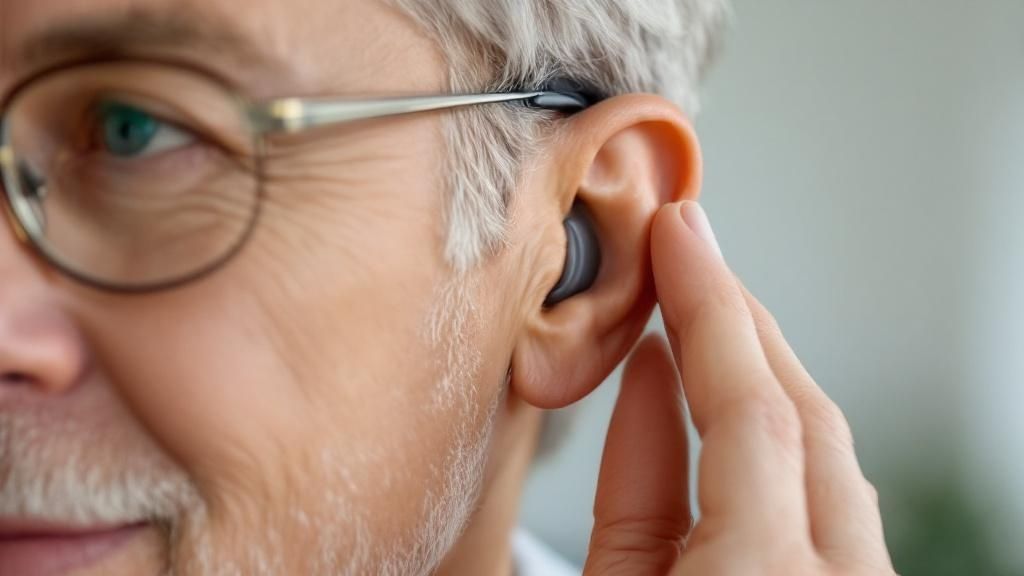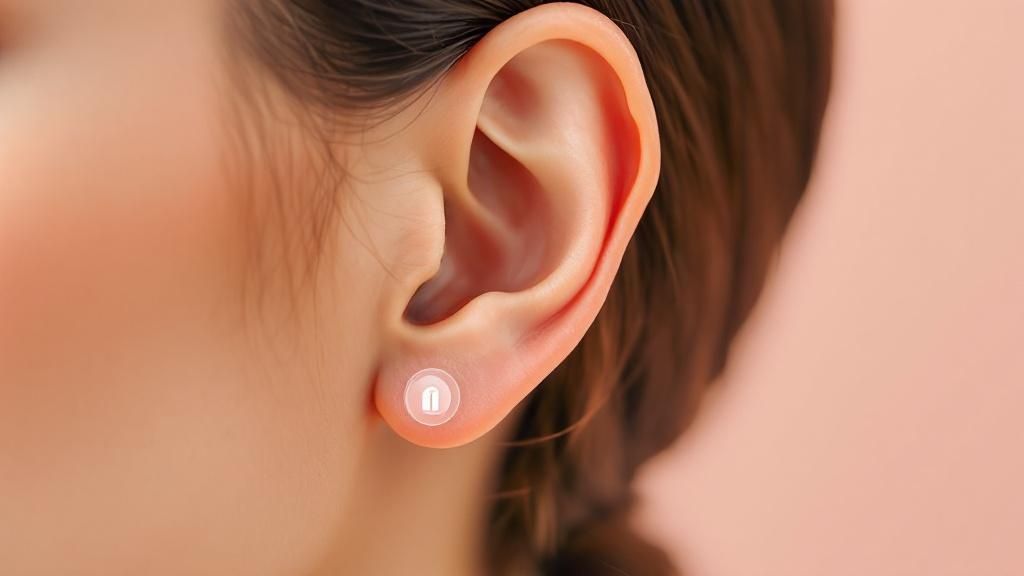Imagine this for a moment. You’re trying to enjoy a quiet conversation, but a dull, nagging ache is building behind your ear. It’s a tiny war zone, a constant battle for that small strip of real estate where two of your most essential tools—your glasses and your hearing aid—are forced to coexist.
Sound familiar?
You’re not alone. But what if I told you that you could make them feel like they weren’t even there? What if you could wear both, all day, in complete, weightless comfort?
It’s not just possible; it’s achievable. The secret isn’t in finding one magical device, but in mastering a few simple techniques that make your glasses and hearing aids work together as a single, harmonious system. This guide will show you how.
From a Crowded Ledge to a Comfortable Coexistence
It’s the subtle friction that drives you crazy, isn’t it? The tangled arms of your glasses catching on your hearing aid every time you put on a mask. The persistent pressure point that whispers of a headache to come. The endless cycle of pushing and prodding to get everything to sit just right, only to have it all shift again moments later.

This isn’t some modern inconvenience. Believe it or not, the struggle is so old that the first patent for combined hearing aid glasses was filed way back in 1909. By the 1960s, these devices were so popular they made up over half of all hearing aid sales. You can discover more insights about the history of hearing aid glasses and see how long we’ve been trying to solve this puzzle.
Why Your Daily Discomfort Is More Than Just an Annoyance
This isn't just about feeling a little uncomfortable. The constant friction behind your ear has real consequences that can sabotage your entire day.
- A Slow Burn of Pain: That relentless pressure isn't imaginary. It’s a physical force that can trigger headaches, soreness, and even raw skin behind your ears.
- The Scourge of Chafing: The constant rubbing and weight, especially on sensitive skin, can lead to redness and irritation that only gets worse as the hours tick by.
- A Betrayal of Sound: And here’s the most critical part. When your glasses push your hearing aid even a millimeter out of its optimal position, it can distort sound, create feedback, and undermine the very reason you’re wearing it.
If you’re nodding along, then you’ve finally found the resource that understands the real problem. Let’s end the frustration and turn those competing gadgets into a natural extension of you.
From Clumsy Fumbling to Effortless Placement
Think about the last time you put on your glasses and hearing aid. Was it a conscious, deliberate process, or a rushed, automatic jumble? True, lasting comfort isn’t an accident; it’s born from a small, intentional ritual.
The goal is to create a system so seamless that both devices feel weightless, secure, almost forgotten. To get there, you need to ditch the random fumbling and adopt a method that works every time.
Let's start with a simple, transformative technique: the Frame First Method.
Always put your glasses on first. Feel them settle into place. The arms should rest flat and secure against your skin. This creates the foundation.
Then, gently slide your hearing aid into the small, waiting space between the glasses arm and your outer ear. This tiny shift in sequence is a revelation. It stops the glasses from knocking the hearing aid out of place and creates a stable, pressure-free fit. Try it right now. You’ll feel the difference.
The Secret Language of a Perfect Fit
How do you know when the fit is right? Your body will tell you. A poor fit feels sharp, specific—a pinpoint of pressure you can’t ignore. A perfect fit, however, feels like nothing at all. The weight is so evenly distributed that your brain stops registering it.
Here are two insider tips to help you achieve that feeling:
- Ask Your Optician for a 'Comfort Channel.' The next time you get new glasses, mention you wear a BTE hearing aid. A skilled optician can subtly adjust the curve of the arms, creating a dedicated groove for your device to nestle into without any pressure.
- Embrace the Power of Thin Arms. Imagine sliding a thick rope and a thin wire into the same small space. Which one fits better? Lightweight, thin-armed frames are your best friends. They occupy less precious real estate, dramatically reducing the chance of conflict and soreness.
A common mistake is to view hearing aids and glasses as two separate problems. The breakthrough comes when you see them as a single, integrated system. Thinking about how they will interact before you buy can save you from months of needless discomfort.
Not sure how your current devices measure up? This quick chart reveals which hearing aid styles are naturally designed to coexist peacefully with glasses.
Hearing Aid Styles and Their Harmony with Glasses
| Hearing Aid Style | Glasses Compatibility Level | The Hidden Challenge | Your Best Strategy |
|---|---|---|---|
| Behind-the-Ear (BTE) | Moderate | Both devices compete for the same patch of skin. | Put glasses on first, then the hearing aid. Seek out thin-armed frames. |
| In-the-Ear (ITE) | Excellent | No external parts to battle with glasses arms. | This style inherently avoids conflict. A natural choice for glasses wearers. |
| In-the-Canal (ITC) | Excellent | Sits entirely inside the ear canal, leaving the outer ear completely free. | No interaction, no friction. A seamless and invisible solution. |
| Completely-in-Canal (CIC) | Excellent | The most discreet option, vanishing inside the ear canal. | Zero interference with any style of glasses. Pure harmony. |
As you can see, some models are born collaborators. If you’re constantly fighting for comfort, the problem might not be the fit—it might be the style itself.

This journey isn’t just about comfort; it's about reclaiming your confidence. When your tools work together, they enhance your clarity, your style, and your presence in the world. If you're exploring options, our guide on how to buy hearing aids offers crucial insights. The path to effortless hearing and sight begins with making the right choice from the start.
Choosing the Right Gear for a Future of Comfort
Let's be honest. All-day comfort isn't something you find later; it's something you design from the beginning. The real secret to wearing a hearing aid with glasses without a second thought is choosing devices that were destined to be teammates, not rivals fighting for that tiny piece of land behind your ear.

Getting this right is a game-changer. Consider this: in 2019, an estimated 73 million people in the U.S. had some form of hearing loss. The truly shocking part? A staggering 85-90% of those with mild-to-moderate loss have never even tried hearing aids. Discomfort is one of the silent barriers, and it's one we can eliminate.
How to Engineer Your Perfect Pair
Think of your hearing aids and glasses as two halves of a whole. When you shop for one, you must be thinking about the other.
Start with your hearing aid. Certain Behind-the-Ear (BTE) models are naturally more glasses-friendly.
- Look for Mini-BTE or RIC (Receiver-in-Canal) styles. Their casings are significantly smaller, leaving more breathing room for your glasses to rest naturally.
- Examine the tubing. The thin, flexible tube that connects the device to the earmold can make a world of difference. The thinner it is, the less friction it creates.
Now, let’s turn to your frames. The right pair will feel like it’s floating, even with a hearing aid nestled right beside it.
The Anatomy of a Glasses-Friendly Frame
Your choice of frames is about so much more than style; it's about physics and engineering.
The secret weapon? Frames with thin, straight arms. In the optical world, they're called "bayonet" or "spatula" temples. They are designed to slide on smoothly without dislodging your hearing aid, distributing pressure evenly instead of digging into one spot.
Material is also a critical piece of the puzzle. Reach for lightweight options like titanium or other flexible alloys. The less weight pressing down on your ears, the less you'll have to think about it.
By taking this design-focused approach—asking your audiologist and optician the right questions—you shift from "making do" to creating genuine harmony. To go even further, exploring a few more hearing aid comfort tips can provide you with an even larger arsenal of strategies.
Unlocking the Secrets of Unshakeable Comfort
You’ve mastered the fundamentals. You have the right devices and a perfect placement routine. You have already solved 90% of the puzzle. Now, it’s time for the final 10%—the insider tricks that elevate your experience from "comfortable" to completely unconscious.
These are the small, often inexpensive accessories that seasoned wearers swear by. If you still feel a hint of friction or a whisper of pressure, don’t accept it as normal. A tiny, clever tool might be all that stands between you and perfect, all-day ease.
Secure Your Investment, Secure Your Peace of Mind
We’ve all felt it. That jolt of panic when you pull off a sweater too quickly and feel your hearing aid shift. It's a legitimate fear, but it's also a solvable one. Retention tools are your new best friend, offering an unshakable fit and priceless peace of mind.
- Hearing Aid Retention Cords: Think of these as a discreet, invisible safety net. A tiny clip attaches to your hearing aid, and the other to your collar. If your device is ever dislodged, the cord catches it. Simple, brilliant, and a massive stress reliever.
- Soft Silicone Sleeves: These are like little pillows for your glasses. They slide onto the arms of your frames, creating a soft cushion exactly where they meet your hearing aid. Say goodbye to those annoying pressure points.
- Specialized Adhesives: For those times when you need a truly locked-in feel—during a workout or a windy day—products like hearing aid tape offer a gentle but firm hold. This body-friendly, double-sided tape keeps your device perfectly positioned, no matter what.
These aren't just gadgets; they are tickets to freedom. They allow you to move through your day without constantly checking if your devices are still secure.
The ultimate goal is to make your hearing aids and glasses feel so much a part of you that you completely forget they're there. When you stop consciously thinking about them, you can finally focus on what truly matters—the sounds and sights of your life.
Banishing the Ghosts of Sound
Sometimes, the problem isn't pressure, but a sound. Have you ever heard that high-pitched whistle when your glasses press against your hearing aid? That’s feedback, a common issue caused when the arm of your glasses gets too close to the device's microphone.
That maddening squeal can be incredibly frustrating, but it's almost always fixable. If you're running into this or other sound quality issues, our comprehensive hearing aid troubleshooting guide is filled with detailed solutions.
Often, a tiny adjustment or one of the accessories above is all it takes to restore crystal-clear sound and achieve that perfect, silent harmony between sight and hearing.
Why Your Confidence Is the Final Piece of the Puzzle

Let’s talk about the strange double standard we all navigate. We see glasses as a fashion statement, a cool accessory that broadcasts personality. Yet, hearing aids can sometimes carry an undeserved stigma, making people feel self-conscious.
Why do we treat these two essential tools so differently?
It’s a simple story of numbers and visibility. Nearly two-thirds of American adults wear glasses, making them completely normal. In contrast, studies show only about 3% of the population wears hearing aids. That familiarity gap plays a huge role in social perception. You can dig deeper into this double standard to understand how our brains process these differences.
The key is to reframe this in your own mind. A hearing aid isn't a sign of weakness; it's a powerful tool for connection. It’s technology that allows you to fully engage with the world and the people you love.
Understanding this dynamic is the first step toward building unshakeable confidence. This journey isn't just about achieving physical comfort. It's about finding the emotional comfort to wear both tools proudly, without hesitation. True harmony begins not behind your ear, but inside your mind.
Answering Your Lingering Questions
Even with the best strategies, a few practical questions always remain. Let's tackle the most common ones so you can move forward with total confidence.
Which Goes On First, My Glasses or My Hearing Aid?
The vast majority of people find success by putting their glasses on first. This creates a stable, predictable foundation. Then, you can gently slide the hearing aid into the small space between the arm of your glasses and your ear.
This sequence usually prevents the hearing aid from being knocked off when you adjust or remove your glasses throughout the day.
But here’s the truth: there is no universal "right" way. The best method is whatever feels most secure and natural for you and your specific devices. Experiment with both and listen to your body.
The most important advice I can offer is this: be gentle. Rushing is the enemy. When you rush, things get tangled and fall. A slow, deliberate motion every single time makes all the difference in the world.
My Ear Is Getting Sore. What Can I Do?
Soreness is your body's signal that there's too much pressure in one specific spot. It’s a common complaint, but it is almost always fixable.
Your first call should be to your optician. Ask them to check the fit of your frames, specifically mentioning your hearing aid. A skilled professional can often make micro-adjustments, reshaping the arms to create a perfect little channel for your hearing aid to rest in.
You can also explore a few game-changing accessories.
- Silicone or foam sleeves that slide onto your glasses' arms can be a lifesaver, adding a soft cushion right where the pressure builds.
- If you're in the market for new devices, ask about smaller BTE models. Modern technology is incredible, and the newer, thinner tubing can dramatically reduce that feeling of bulkiness behind your ear.
One final pro tip: at the end of a long day, gently massaging the area behind your ears for a minute or two can soothe any lingering aches and restore circulation.
At HearDirectClub, we believe clear hearing should never come at the cost of comfort. Our hearing aids are engineered to be powerful yet discreet, making them an ideal partner for glasses wearers. Discover how comfortable they can be by visiting https://heardirectclub.com.





Leave a comment
This site is protected by hCaptcha and the hCaptcha Privacy Policy and Terms of Service apply.